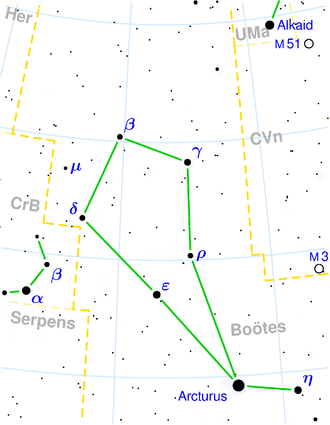IC 1006
| Galaxie IC 1006 | |
|---|---|
 | |
| SDSS-Aufnahme von IC 1006 | |
| AladinLite | |
| Sternbild | Bärenhüter |
| Position Äquinoktium: J2000.0, Epoche: J2000.0 | |
| Rektaszension | 14h 22m 59,1s[1] |
| Deklination | +23° 47′ 40″[1] |
| Erscheinungsbild | |
| Morphologischer Typ | S[1] |
| Helligkeit (visuell) | 14,5 mag[2] |
| Helligkeit (B-Band) | 15,3 mag[2] |
| Winkelausdehnung | 1′ × 0,6′[2] |
| Positionswinkel | 90°[2] |
| Flächenhelligkeit | 13,8 mag/arcmin²[2] |
| Physikalische Daten | |
| Zugehörigkeit | isoliert[1] |
| Rotverschiebung | 0.017139 ± 0.000103[1] |
| Radialgeschwindigkeit | 5138 ± 31 km/s[1] |
| Hubbledistanz vrad / H0 | (232 ± 16) · 106 Lj (71,1 ± 5,0) Mpc [1] |
| Geschichte | |
| Entdeckung | Truman H. Safford |
| Entdeckungsdatum | 14. Mai 1866 |
| Katalogbezeichnungen | |
| IC 1006 • PGC 51378 • CGCG 133-045 • MCG +04-34-023 • KUG 1420+240 • 2MASX J14225909+2347393 • GALEXASC J142259.13+234740.2 • KIG 628 | |
IC 1006 ist eine Spiralgalaxie vom Hubble-Typ S im Sternbild Bärenhüter am Nordsternhimmel. Sie ist schätzungsweise 232 Millionen Lichtjahre von der Milchstraße entfernt und hat einen Durchmesser von etwa 70.000 Lichtjahren.
Im selben Himmelsareal befinden sich u. a. die Galaxien NGC 5581 und NGC 5610.
Das Objekt wurde am 14. Mai 1866 vom US-amerikanischen Astronomen Truman Henry Safford entdeckt.[3]
Weblinks
Einzelnachweise
Auf dieser Seite verwendete Medien
Autor/Urheber: Sloan Digital Sky Survey, Lizenz: CC BY 4.0
The sky image is obtained by Sloan Digital Sky Survey, DR14 with SciServer.
Angle of view: 4' × 4' (0.3" per pixel), north is up.
Details on the image processing pipeline: https://www.sdss.org/dr14/imaging/jpg-images-on-skyserver/



